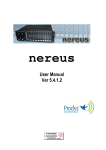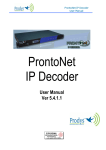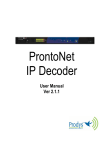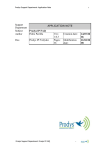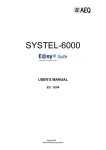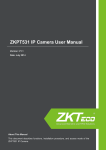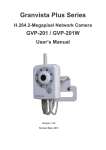Download What`s new v6.3.3
Transcript
Change Log July 2010 INDEX New Automatic Jitter Buffer .......................................................... 4 Enhanced N+k redundancy protocol .................................................. 5 Shorter Time Between Packets for PCM and SIP.................................... 5 Bandwidth and Overhead information including FEC info......................... 6 ProntoNet Model and Version in SIP’s User Agent field............................ 7 New RTP automatic connection. ...................................................... 7 PCM 20 bits@32 Khz in V4 protocol ................................................... 9 New user configurable alarm description............................................ 9 Alarm warning on the front panel display ..........................................10 SDK available in portable units.......................................................10 New SDK commands....................................................................11 New alarm event to notify unsuccessful scheduled calls.........................11 Loop activation and test tones .......................................................12 Ethernet port configuration on the front panel and web page ..................12 Some parameters can be changed when lines are connected ...................13 New numeric keypad on the dial window of the web page ...................... 14 Apt-X at high bit rates with double IP mode .......................................14 Disconnection reason on the Call Log ...............................................14 Possibility of ignoring IP remote disconnection orders ...........................15 Auxiliary data at 19200 bps ...........................................................15 New battery charge information on the front panel display.....................16 New menu layout on the Nomada IP and Nomada IP XL ..........................17 Call Log remains at the web when accessed via ProdysControl ................. 17 New GPO option on Nomada IP and Nomada IP XL ............................... 17 Enhanced STUN Protocol ..............................................................18 SIP: Automatic disconnection ........................................................18 Model and firmware version on the user-agent SIP field .........................18 Prodys S.L. Tel: +34 91 6896880 Θ Fax: +34 91 6943777 Θ Email: [email protected] Θ Web: www.prodys.com Page 2 Accessing ProdysControl phone book and Windows 2000.........................18 3G access with roaming ............................................................... 19 The ‘inverted’ parameter for Layer III on ISDN is available on the front panel menu .....................................................................................19 Wrong Vu-Meter values via the SDK commands....................................19 ISDN audio mode selection on the front panel.....................................19 Prodys S.L. Tel: +34 91 6896880 Θ Fax: +34 91 6943777 Θ Email: [email protected] Θ Web: www.prodys.com Page 3 01-07-2010 Date Version New V6.3.3 New Automatic Jitter Buffer From this version onwards, it is possible to configure the jitter buffer to adjust itself automatically to the jitter of the network. As it can be seen in the picture below, when configuring the buffer to ‘Auto’, a maximum value for the buffer might be defined, in order to prevent the buffer from growing beyond a maximum delay level. When the buffer is configured to adjust automatically to the jitter of the network, this buffer will grow every time the measured jitter of network goes beyond the jitter buffer value, till it reaches the maximum value, when defined. Prodys S.L. Tel: +34 91 6896880 Θ Fax: +34 91 6943777 Θ Email: [email protected] Θ Web: www.prodys.com Page 4 The other option is to configure the buffer manually, as it was prior to this new version. New Enhanced N+k redundancy protocol This version supports an enhanced version of the Prodys N+1 Redundancy Protocol. For more information about this, please refer to the document Prodys Reliable Configurations.pdf, available on the Support Documents in the download section of Prodys Web Page. New Shorter Time Between Packets for PCM and SIP In prior versions, when the unit was configured to work with SIP protocol, the audio mode was set to PCM, and the FEC option was activated, the shorter value for the Time Between Packets parameter was 5msc, which caused packet fragmentation. Now, it is possible to set the Time Between Packets parameter to 4msc, with the same configuration detailed above, in order to avoid packet fragmentation. Prodys S.L. Tel: +34 91 6896880 Θ Fax: +34 91 6943777 Θ Email: [email protected] Θ Web: www.prodys.com Page 5 New Bandwidth and Overhead information including FEC info The information about the required bandwidth and the overhead can be configured now to include information about the FEC mechanism. Prodys S.L. Tel: +34 91 6896880 Θ Fax: +34 91 6943777 Θ Email: [email protected] Θ Web: www.prodys.com Page 6 As it can be seen in the picture above, the user can get information about the overall bandwidth requirements (audio + FEC), or just the requirements for either the audio or the FEC mechanisms individually. New ProntoNet Model and Version in SIP’s User Agent field. SIP’s User Agent field contains now information about which ProntoNet model generates the IP traffic. Information about firmware version is also included in that field. New New RTP automatic connection. In the RTP configuration menu, a new automatic answering mode compatible with Mayah and Luci has been implemented. In this mode, the unit is constantly scanning the RTP port and, when incoming traffic is detected from another codec, connects to this codec using the same audio configuration Prodys S.L. Tel: +34 91 6896880 Θ Fax: +34 91 6943777 Θ Email: [email protected] Θ Web: www.prodys.com Page 7 This new automatic mode works as follows: after clicking on the connection bar, Tx and Rx connect automatically but the word “Stopped” appears on the Decoder. This is an indication that the unit is waiting to receive the incoming data. When the first packets aimed at the specified port are received, the word “Stopped” will change to “Searching” first and, when the audio gets framed, the audio configuration will be shown. If the connection is lost, the word “Stopped” will be shown again, waiting for the reception of a new call. Prodys S.L. Tel: +34 91 6896880 Θ Fax: +34 91 6943777 Θ Email: [email protected] Θ Web: www.prodys.com Page 8 New PCM 20 bits@32 Khz in V4 protocol V4 protocol permits now the coding of PCM using 20 bits and 32 KHz. New New user configurable alarm description The user can enter a custom description for each alarm event. This description will appear on the alarm log on a new column called ‘Custom Description. Please, take a look at the picture below, illustrating how to assign the sentence ‘Audio framing got lost’ to the ‘Decoder Frame lost’ alarm. In the following picture, it can be seen how this description appears in a new column of the alarm log called ‘Custom Description’: Prodys S.L. Tel: +34 91 6896880 Θ Fax: +34 91 6943777 Θ Email: [email protected] Θ Web: www.prodys.com Page 9 New Alarm warning on the front panel display From this version onwards, when an alarm is still active, this warning message will be shown on the front panel display: ##### ALARM ##### ##### ACTIVE ##### An alarm event is still active when the condition that raised the alarm remains. An alarm event is not checked when the alarm event finished, meaning that the condition that activated the alarm is gone, but the alarm was not checked on the alarm log by the user. In this situation, no message will appear in the front panel display This new warning message on the front panel display will alternate with the main information window every few seconds. Of course, once the user enters the main menu, this information will not appear till the user goes out from the menu or the user stop using it for some seconds. This information will not appear only in the case the user has entered the information window by pressing the INF key on the front panel keypad. This warning message will not appear in the Nomada IP and Nomada IP XL displays. New SDK available in portable units From this version on, SDK commands can be used in all Prodys’ portable units: PortaNet, Nomada IP and Nomada IP XL. Prodys S.L. Tel: +34 91 6896880 Θ Fax: +34 91 6943777 Θ Email: [email protected] Θ Web: www.prodys.com Page 10 New New SDK commands Some new SDK commands are available. For more information about this, please refer to the latest version of SDK User Manual available on the download section of Prodys web page along with this document. New New alarm event to notify unsuccessful scheduled calls This new alarm event is called ‘Scheduled Call failed’, and it was included in the ‘connection’ section in the alarm configuration window. Here follows the conditions that would raise this new alarm event: Prodys S.L. Tel: +34 91 6896880 Θ Fax: +34 91 6943777 Θ Email: [email protected] Θ Web: www.prodys.com Page 11 - The scheduled call did not succeed. A higher priority call was already in progress so it could not be established. It is not possible to set the network link defined for the call. It is not possible to select the compression mode defined for the call. The column ‘Value’ on the alarm log window will show which of the reasons above triggered the alarm. New Loop activation and test tones This version includes a Test option in the audio configuration menu that permits loop activation and input and output test tone generation. Loop activation is no longer located in the Sys menu. New Ethernet port configuration on the front panel and web page With this new version, the Ethernet port configuration can be checked both on the front panel menu in the INF->LAN option, and on the web page under the ‘Ethernet port’ tab in the Configuration window: Prodys S.L. Tel: +34 91 6896880 Θ Fax: +34 91 6943777 Θ Email: [email protected] Θ Web: www.prodys.com Page 12 This information is specially helpful when configuring the Ethernet port to ‘Auto’ mode. New Some parameters can be changed when lines are connected In previous versions, it was not possible to change some configuration variables when either one line or both of them were connected. Now it is possible to access and make changes on the following sections of the configuration menu even thought either one or both lines are connected. 1.- It is possible to enter the ISDN configuration if the selected audio interface is not ISDN. 2.- The time and date configuration window is now accessible when lines are connected. 3.- The alarms configuration window is also accessible. 4.- Net BackUp configuration window can be configured while lines are Prodys S.L. Tel: +34 91 6896880 Θ Fax: +34 91 6943777 Θ Email: [email protected] Θ Web: www.prodys.com Page 13 connected. New New numeric keypad on the dial window of the web page A new numeric keypad is available at the Dial window of the web page to enter the destination address without the need of a physical keypad. This is quite useful for those users that do not use a keypad, but only the mouse, to control their applications. To open the numeric keypad just click on the green keypad icon at the right side of the text box to enter the destination address. New Apt-X at high bit rates with double IP mode In previous versions, apt-X was limited to 64kbps on the second line for IP connections. From this version onwards, it is possible to configure the encoder of line 2 at a bit rate of 128 kbps with apt-X compression mode. New Disconnection reason on the Call Log The disconnection reason is included in the Call Log. This way, the user can know the reason why any of the registered calls was terminated. In case of an ISDN call, the disconnection reason will be notified as a code. A table with the disconnection Prodys S.L. Tel: +34 91 6896880 Θ Fax: +34 91 6943777 Θ Email: [email protected] Θ Web: www.prodys.com Page 14 codes for ISDN calls is available on the Prodys IP Family User Manual. In this example, we have two ISDN calls, first two calls, ended with termination code 16, meaning that the call was terminated normally by either of the two ends. Below these two calls, we have three IP connections. One of them was terminated at the remote end, and the other two calls were terminated locally. In case of an IP connections, there are three disconnection reasons: -The connection was dropped locally: ‘Manually disconnected’. -The connection was terminated at the remote end: ‘Remotely disconnected’. -The connection finished because a line drop: ‘Connection dropped’. New Possibility of ignoring IP remote disconnection orders A new option has been included in “advanced options”: “IP:Ignore Remote Disconnect Request” New Auxiliary data at 19200 bps The auxiliary data port has been modified to reach 14400, 19200, 38400, 57600 and 115200 bps, with the condition that the port at that velocity works with short data bursts and that the average speed doesn’t exceed 9600 bps. Prodys S.L. Tel: +34 91 6896880 Θ Fax: +34 91 6943777 Θ Email: [email protected] Θ Web: www.prodys.com Page 15 New New battery charge information on the front panel display In the Nomada units, the remaining time of battery charge is indicated on the front panel display by pressing the INF key. This time indication is an estimation based on the battery charge. Prodys S.L. Tel: +34 91 6896880 Θ Fax: +34 91 6943777 Θ Email: [email protected] Θ Web: www.prodys.com Page 16 New New menu layout on the Nomada IP and Nomada IP XL The main menu layout was changed on Nomada IP and Nomada IP XL units to ease access to the audio and presets options. These two options are supposed to be accessed more often than any other, so they have been moved to the top of the menu, so that non experienced users might find them more easily. The menu layout was changed so that the fist menu will be the following: { A U D N I O O M } A P D R A E S M E E T N S U M E N U Under the ‘MENU’ option, the user will find the rest of options as they were in previous versions. New Call Log remains at the web when accessed via ProdysControl From this version onwards, when the unit is being controlled via ProdysControl, the call log entries remain accessible via the web interface. In previous versions, once the unit was accessed via ProdysControl, the entries of the call log were removed and stored on the ProdysContol database. This behaviour has been changed so that they remain available via the web page. New New GPO option on Nomada IP and Nomada IP XL A new option to enable a GPO is available on Nomada IP and Nomada IP XL. This option will activate a GPO when one of the mic/line inputs was enabled and connected to the main line or PGR channel. This option is called ‘MIC/LINE Input On’. Prodys S.L. Tel: +34 91 6896880 Θ Fax: +34 91 6943777 Θ Email: [email protected] Θ Web: www.prodys.com Page 17 New Enhanced STUN Protocol -STUN Protocol: The STUN protocol has been enhanced to achieve NAT traversal techniques. STUN protocol was used in previous version just to get the public IP address when calling through a NAT device, such as a router. From this version onwards, it has been used to get the ports used by the NAT device, allowing the unit to establish IP connections through routers with no configuration, as long as the router is not a ‘symmetric NAT’ one (this is a well know limitation of this protocol to achieve NAT traversal). Ask to [email protected] for more information. New SIP: Automatic disconnection Automatic disconnection with SIP protocol: Given that SIP does not define a way to detect that the audio connection dropped, some different techniques can be used to do it. We have adopted the most common one in this version: if the decoder loses framing for at least 30 seconds, the unit drops the line to inform the customer about such a situation. New Model and firmware version on the user-agent SIP field The User-Agent field of SIP protocol frames indicates now the product model and firmware version. Example: User-Agent: ProntoNet v6.3.3 Fix Accessing ProdysControl phone book and Windows 2000 This problem rarely appears on computers with Windows 2000 as operating system. The problem appears when accessing the DIAL window via the ProdysControl software on one unit and selecting the ‘Phone book’ tab. Depending on the contents of the phone book, ProdysControl Client application might freeze when accessing the phone book. Even though this problem depends on the operating system and only appears on Windows 2000, it was fixed changing the way of access to the phone Prodys S.L. Tel: +34 91 6896880 Θ Fax: +34 91 6943777 Θ Email: [email protected] Θ Web: www.prodys.com Page 18 book on the OCX of the web page, that is also used by ProdysControl to display the user interface. Fix 3G access with roaming When the SIM card used to access the 3G network was enabled for roaming, and the roaming service was in use, there were some problems to access and register with the provider. Fix The ‘inverted’ parameter for Layer III on ISDN is available on the front panel menu From this version onwards, the ‘inverted’ parameter for Layer III when sending audio over ISDN is also available on the front panel menu. This parameter should be checked normally to assure compatibility with most of major manufacturers. For more information about this and ISDN compatibility in general, please download the file ISDN Compatibility.zip at the Support Document area in the download section of Prodys Web Page. Fix Wrong Vu-Meter values via the SDK commands The VU-Meter values obtained via the SDK protocol were not correct. Fix ISDN audio mode selection on the front panel When the second line was connected on ISDN, it was not possible to select any compression mode other than G711 on line 1. This issue has been fixed in this version. Prodys S.L. Tel: +34 91 6896880 Θ Fax: +34 91 6943777 Θ Email: [email protected] Θ Web: www.prodys.com Page 19





















